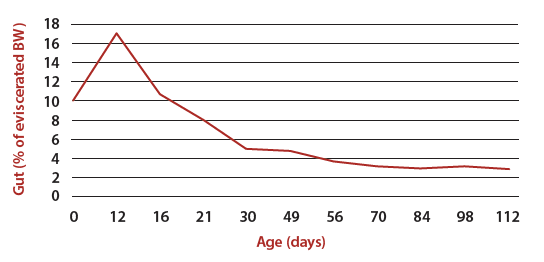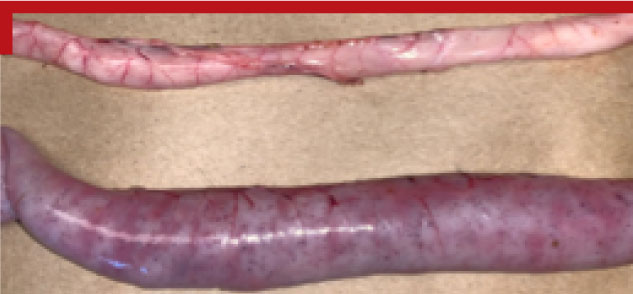By Dr. LLoyd Weber
Poultry Veterinarian,
LLoyd Weber Consulting Service
Arguably the digestive system is the hardest working organ in the bird. It has been well documented that the performance of a commercial chicken flock is highly dependent on the gut health status of the birds. The digestive tract is analogous to a tunnel running through the body. With its many folds, villi and micro villi the digestive tract provides a very large surface area for digestion and absorption of nutrients. Due to the direct contact with the surroundings, the digestive system also functions as an environmental sensing organ.
The digestive tract contains a diverse community of bacteria, viruses, fungi, protozoa, etc., all mixed with consumed feed and water. This diverse collection of organisms, food and water is often referred to as the “Gut Microbiome”. The development of this gut microbiota begins at hatching as bacteria are picked up from the environment, and matures over a period of 3-4 weeks. If digestion or absorption is compromised an imbalance of the gut microbiotia can occur, which will affect the bird’s health and performance. Important roles of the gut microbiota include preventing the growth of less favourable or pathogenic bacteria such as Salmonella, in addition to contributing to the development and maturation of the bird’s immune system. Birds lacking a good gut microbiota usually have poorly developed immune tissues and have been shown to be more susceptible to disease. The balance of the microbiota of the gut can be affected by the environment and bird management. The bird’s environment is broad term, which includes feed, litter, biosecurity, light, air, and water.
Factors affecting the gut are:
Feed: This is likely one of the most important factors to gut health. The feed needs to provide easily digestible nutrients to the bird, and encourage a beneficial gut microflora, Dr. Zuidhof of the University of Alberta emphasizes the importance of gut health starting at placement (Figure 1). The gut to body weight ratio is highest during the first 13-days than at any other time in the bird’s life. Newly placed chicks are eager to reach feed as soon as possible therefore having extra feed readily accessible to the flock starting at day of placement is crucial. The feed texture is also important, coarse dietary real grain particles improve digestion by promoting a more athletic gizzard. This increases acid and helps enzymes to help break down nutrients in the upper intestine leaving little undigested material to feed clostridial bacteria in the lower gut.
Figure 1: Chick Intestinal weight: body weight is at its highest within 2-weeks of age.

Litter: All birds pick in the litter which is typical of their natural behaviour. The foreign bacteria or protozoa picked up from the litter stimulates an immune response which contributes to the development of healthy gut immune tissue. The gut lining forms an interface between these foreign materials such as feed, litter, pathogenic bacteria and the bird. The gut microbiome balance has an essential role in minimizing gut inflammation.
Dr. Nurmi pioneered the concept that early exposure to favourable bacteria actually prevented challenge by pathogenic bacteria such as Salmonella. This concept has been coined as the “Probiotic Effect”. “Raised Without Antibiotics” production systems depend on establishing immunity against coccidiosis and this is only accomplished by cycling the coccidiosis vaccine in barn via litter picking. Coccidiosis outbreaks occur when the bird picks up too many pathogenic coccidia and overwhelm the immune system. A low number and early ingestion of coccidia gives the bird time to develop immunity without mortality or clinical coccidiosis. Avoiding excessively wet or dry litter is an important objective. Having too high a litter moisture at the wrong time provides a good medium for pathogen growth, and also promotes foot pad ulcers leading to ascending infections and lameness. Overly dry litter promotes a dusty environment and disrupts coccidiosis vaccine cycling. Incorrect brooding temperature or high ammonia levels as a result of excessive litter moisture contributes to stressful conditions resulting in low feed intake and low average daily gain.
BioSecurity: This involves the active reduction of infectious agents in the bird vicinity. For example; a high population of darkling beetles results in poor biosecurity since these insects can carry many pathogens such as Salmonella, infectious bursal disease virus and E.coli and are often present in the litter. Cleaning and disinfection effectively reduces the amount of ‘bad’ bacteria in the environment, making it less likely for the bird to encounter a virulent pathogen.
Figure 2: comparison between a normal intestine (top) and a case of clinical coccidiosis (bottom)

Air: Poor air quality, resulting in high relative humidity and ammonia concentrations, damages the bird’s defence mechanisms in the respiratory tract which lead to increased susceptibility to viral or bacterial outbreaks. Wet litter and its negative effects are often preceded by an extended period of high relative humidity. Wet litter is a perfect medium for bacterial growth and even mild infections can be costly. A low level of E.coli can have a heavy impact on flock performance by redirecting the use of quality nutrients away from growth towards immune system functions to fight pathogen colonization.
Water: The normal low pH of the crop, proventriculus and gizzard favours the growth of lactobacilli, which aid in the digestion of carbohydrates. The benefits of acidifying the drinking water works similarly, where it helps maintain the low pH in the crop and gizzard, leading to efficient digestion of nutrients and promotes probiotic growth2. In addition to improving bird performance, including buffered organic acids helps maintain water line function by descaling drinkers and nipples. Water quality is also an aspect of biosecurity. Consistent infections and poor performance are often a result of contaminated water lines. The bacteria first colonize the digestive tract then enter general circulation settling in the liver, lungs and heart. The incorporation of chlorine dioxide(Di-O-Clean), chlorine or hydrogen peroxide at the proper dose effectively removes biofilm and kills pathogens in the water line.
The digestive tract is closely associated with the birds’ outside surroundings; in order to achieve the best performing flock, the environment needs to be suited to promote a healthy gut. Factors which contribute to a healthy intestinal tract are a proper diet, dry litter, heightened biosecurity, adequate lighting, good air quality and an appropriate water sanitation program.
Mismanagement of any of these elements can disrupt the fine balance of the bird’s digestive system leading to poor flock health and performance
1. E. Nurmi, M. Rantala. New aspects of Salmonella infection in broiler production. Nature, 241, (1973), pp. 210-211
2. Hamid, Humera & Shi, H & Ma, G & Fan, Y & Li, W & Zhao, Lihong & Zhang, J & Ji, Cheng & Ma, Qiugang Influence of acidified drinking water on growth performance and gastrointestinal function of broilers. Poult Sci, 97, (2018), pp. 3601-3609
This article was written for the Fall 2020 Poultry Grist. To read the whole Poultry Grist, click the button below.

